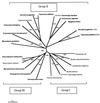Sequencing, cloning, and high-level expression of the pfp gene, encoding a PP(i)-dependent phosphofructokinase from the extremely thermophilic eubacterium Dictyoglomus thermophilum
- PMID: 10913106
- PMCID: PMC94644
- DOI: 10.1128/JB.182.16.4661-4666.2000
Sequencing, cloning, and high-level expression of the pfp gene, encoding a PP(i)-dependent phosphofructokinase from the extremely thermophilic eubacterium Dictyoglomus thermophilum
Abstract
The sequencing, cloning, and expression of the pfp gene from Dictyoglomus thermophilum, which consists of 1,041 bp and encodes a pyrophosphate-dependent phosphofructokinase, are described. A phylogenetic analysis indicates that the enzyme is closely related to the pyrophosphate-dependent enzyme from Thermoproteus tenax. The recombinant and native enzymes share a high degree of similarity for most properties examined.
Figures






Similar articles
-
Purification and properties of the pyrophosphate-dependent phosphofructokinase from Dictyoglomus thermophilum Rt46 B.1.Extremophiles. 1999 May;3(2):131-7. doi: 10.1007/s007920050108. Extremophiles. 1999. PMID: 10356999
-
PPi-dependent phosphofructokinase from Thermoproteus tenax, an archaeal descendant of an ancient line in phosphofructokinase evolution.J Bacteriol. 1998 Apr;180(8):2137-43. doi: 10.1128/JB.180.8.2137-2143.1998. J Bacteriol. 1998. PMID: 9555897 Free PMC article.
-
Sequencing, high-level expression and phylogeny of the pyrophosphate-dependent phosphofructokinase from the thermophilic spirochete Spirochaeta thermophila.Arch Microbiol. 2001 Apr;175(4):308-12. doi: 10.1007/s002030100265. Arch Microbiol. 2001. PMID: 11382227
-
Sequencing, cloning and expression of a beta-1,4-mannanase gene, manA, from the extremely thermophilic anaerobic bacterium, Caldicellulosiruptor Rt8B.4.FEMS Microbiol Lett. 1996 Jul 15;141(1):37-43. doi: 10.1111/j.1574-6968.1996.tb08360.x. FEMS Microbiol Lett. 1996. PMID: 8764509
-
Pyrophosphate-dependent phosphofructokinase from Thermoproteus tenax.Methods Enzymol. 2001;331:54-62. doi: 10.1016/s0076-6879(01)31046-7. Methods Enzymol. 2001. PMID: 11265483 No abstract available.
Cited by
-
Thermotoga maritima phosphofructokinases: expression and characterization of two unique enzymes.J Bacteriol. 2001 Jan;183(2):791-4. doi: 10.1128/JB.183.2.791-794.2001. J Bacteriol. 2001. PMID: 11133978 Free PMC article.
-
The more we learn, the more diverse it gets: structures, functions and evolution in the Phosphofructokinase Superfamily.Biochem J. 2025 May 6;482(9):467-483. doi: 10.1042/BCJ20253024. Biochem J. 2025. PMID: 40329473 Free PMC article. Review.
-
Structural and functional roles of Cys-238 and Cys-295 in Escherichia coli phosphofructokinase-2.Biochem J. 2003 Nov 15;376(Pt 1):277-83. doi: 10.1042/BJ20030795. Biochem J. 2003. PMID: 12927023 Free PMC article.
-
The phosphofructokinase-B (MJ0406) from Methanocaldococcus jannaschii represents a nucleoside kinase with a broad substrate specificity.Extremophiles. 2007 Jan;11(1):105-14. doi: 10.1007/s00792-006-0018-1. Epub 2006 Oct 5. Extremophiles. 2007. PMID: 17021658
-
Carbohydrate metabolism in Archaea: current insights into unusual enzymes and pathways and their regulation.Microbiol Mol Biol Rev. 2014 Mar;78(1):89-175. doi: 10.1128/MMBR.00041-13. Microbiol Mol Biol Rev. 2014. PMID: 24600042 Free PMC article. Review.
References
-
- Altschul S F, Gish W, Miller W, Myers W, Lipman D L. Basic local alignment search tool. J Mol Biol. 1997;215:403–410. - PubMed
-
- Auzat I, Le Bras G, Branny P, Torre F D L, Theunissen B, Garel J-R. The role of Glu 187 in the regulation of phosphofructokinase by phosphoenolpyruvate. J Mol Biol. 1994;235:68–72. - PubMed
-
- Baltscheffsky H, editor. Origin and evolution of biological energy conversion. New York, N.Y: VCH Publishers; 1996. Energy conversion leading to the origin and early evolution of life: did inorganic pyrophosphate precede adenosine triphosphate? pp. 1–9.
-
- Berger S A, Evans P R. Active-site mutants altering the cooperativity of E. coli phosphofructokinase. Nature. 1990;343:575–576. - PubMed
Publication types
MeSH terms
Substances
LinkOut - more resources
Full Text Sources
Miscellaneous

